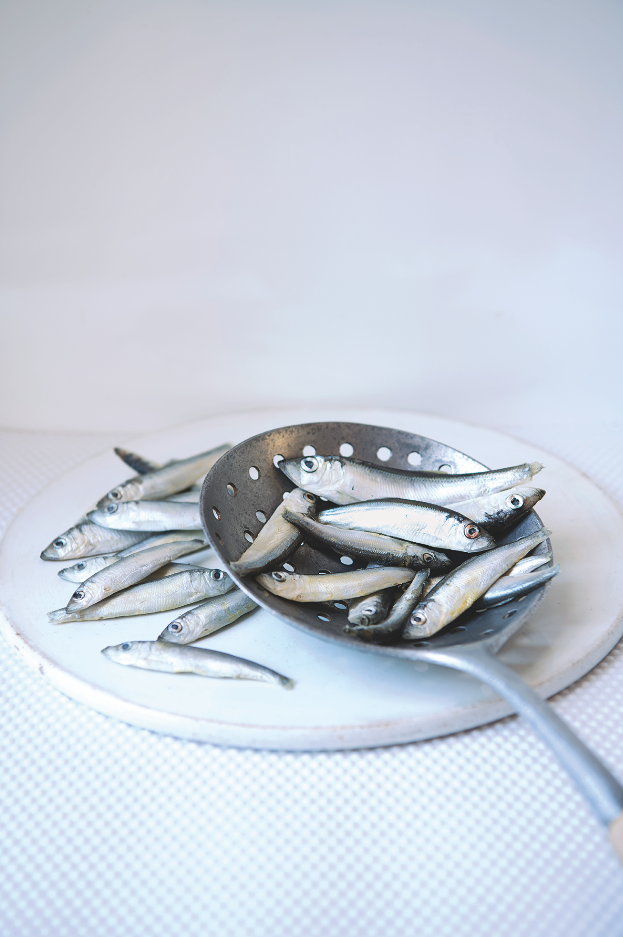Get Premium access to all the latest content online
Subscribe and view full print editions online... Subscribe
Historically a hit with diplomats and ‘the lower order of epicures’ alike, these tiny, young fish are at their tastiest deep-fried and served hot from the pan. Clarissa Hyman talks tiddlers
The most fascinating fact about whitebait is that it does not exist. Honest. I'm not suggesting that you are hallucinating when you pop a deliciously crunchy, deep-fried fishy in your mouth, but what you are not eating is a species called whitebait.
It's a question that used to cause much scratching of the head but, in Britain, the term refers to the young fry of small fish, particularly sprat, sometimes herring or shad. In France and Spain, they are tiny, juvenile anchovies and sardines, and in the United States, especially New England and Long Island, they are usually silversides or sand eels. According to the Oxford English Dictionary, the whitebait name derives from their use as bait for catching other fish.
In the early 17th century, such small fry were found in huge quantities in the tidal waters of the Thames and elsewhere, caught in long bag nets. The story goes that a certain Richard Cannon of Blackwall in 1780 first persuaded the local tavern keepers to serve regular whitebait dinners. The late food historian Alan Davidson wrote that Cannon had problems with the authorities who argued, correctly, the practice meant the mass consumption of immature herring with potentially damaging consequences for the species. Cannon, however, convinced the Lord Mayor of London that whitebait were a distinct species, supported in his view by many natural historians of the day. A Frenchman, Valenciennes, even introduced a new genus, Rogenia, to strengthen the claim.
The controversy raged but sweet, succulent and crispy whitebait became ever more popular with both the rich and fashionable and what one author called ‘the lower order of epicures’. Whitebait feasts reached their peak in the 19th century, when it was a pleasant late-summer outing to travel down the river to luncheon at Greenwich, where, in an inn overlooking the river, the whitebait were cooked fresh from the nets. According to Dorothy Hartley, classic chronicler of English food, while waiting for the whitebait to be cooked, water-souchy, a clear, green broth made from parsley and the small odd fish that were caught in the whitebait nets, was usually served. As she says, this was excellent ‘while chatting to your friends, watching the river traffic and awaiting the whitebait’.
Fried whitebait, like turtle soup, was also once considered an indispensable dish for all diplomatic dinners in London. However, as Queen Victoria’s chef Charles Elmé Francatelli explained, ‘Owing to the extreme delicacy of this fish and its very fragile nature, it cannot be conveyed any distance during the season without injuring its quality, neither can it be kept many hours after it has been taken. Hence the custom of eating it absolutely fresh out of the water at Greenwich.’ Indeed, a gathering for the British Prime Minister and his cabinet, revolving around the consumption of these tiny, translucent fish, became a hotly-anticipated annual event at the Trafalgar, Greenwich, just before the close of the session. This custom continued until 1895, with Her Majesty’s Opposition dining at the Ship Tavern, situated nearby.
One tradition lives on: the annual Whitebait festival in Southend, usually held in September. It opens with the blessing of the catch, when the mayor of Southend goes to watch fishermen haul in the nets.
The whitebait is brought in to the pier and taken to the banqueting hall, where it is prepared and cooked and served at the evening banquet.
Whitebait is a delicacy that depends a great deal on the manner in which it is sorted and cooked. Reporting on a Southend banquet in 1934, The Times commented that, ‘Lilies that fester smell far worse than weeds; whitebait ill-cooked is much nastier than salt cod, and many are the people who do not like whitebait because they have never tasted whitebait worthily cooked and served.’
Poor cooking may be one reason whitebait fell out of popularity; deep-frying, with its unhealthy connotations, may be another. Local fisheries in the shallow, estuarial waters of the south coast declined as a result; imported and subsidised frozen whitebait, mostly from Holland, also proved much cheaper. As the catch of herring under 20cm is now avoided, the fish described as whitebait are mostly more sustainable sprats from the Baltic Sea, but depending on the source these may be mixed with the young of shad, herrings, sticklebacks, gobies and shrimps. It is often difficult to identify different species when they are so small, meaning that in some fisheries, the monitoring of the actual catch may be skewed.
The classic way of cooking whitebait – indeed practically the only way – is to deep-fry them. Dorothy Hartley in the 1950s suggested the fish should initially be rinsed in strongly-salted water before flouring, drying and frying – unless you were lucky enough to find untainted seawater. This makes the coating even and results in a crisp finish. Cayenne or chilli powder can be added to the seasoned flour for a spicy, devilled kick. Another trick is to tip them into a sieve to shake off the excess flour. Frying them in small batches prevents them also from clumping together or turning soggy. As soon as they are a polished, gold-tinted silver, the little fish should be served piping hot from the pan, eaten whole, lock stock and barrel; the only accompaniment necessary is brown bread and butter and lemon wedges. For a fish that doesn’t exist, it’s amazing just how many of them you can eat.

Subscribe and view full print editions online... Subscribe